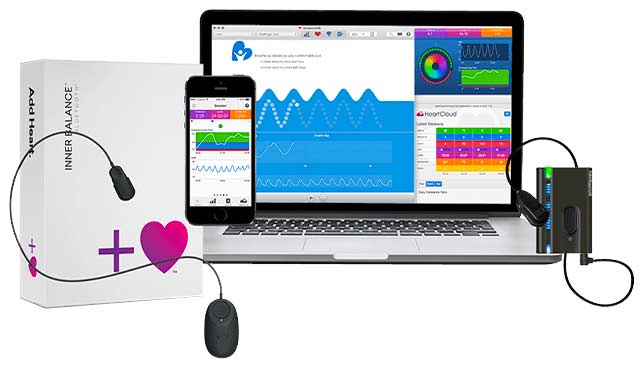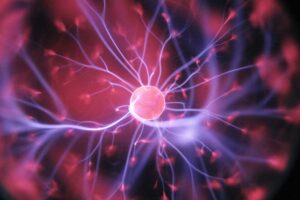HeartMath technology is an innovative approach to improving emotional wellbeing.
Learn to change your heart rhythm pattern to create physiological coherence; a scientifically measurable state characterized by increased order and harmony in our mind, emotions, and body.
I have been using HeartMath technology for years and find it an amazing tool to quickly shift into a balanced, inner calm state of being.
Having a direct “window” into what your physiology is up to – in the moment of checking in – is a great way to learn to get feedback on your biological function and how you’re handling stress on a regular basis.
What I have found is that I might not feel like I’m stressed, but when I check in to my physiology, sometimes the story is much different.
We learn to adapt to stress, which is a good thing. But learning to regulate stress physiologically and to discern when it might be helpful to do so, is a whole other strategy for developing resilience to life’s unexpected twists and turns.
This article dives deeper into the biofeedback technology and why Heart Rate Variability (HRV) is an important indicator of overall health and wellbeing.
The rest of the article was compiled directly from HeartMath’s website.
Here’s a short introductory video on HeartMath and heart coherence.
The Heart–Brain Connection
Most of us have been taught in school that the heart is constantly responding to “orders” sent by the brain in the form of neural signals. However, it is not as commonly known that the heart actually sends more signals to the brain than the brain sends to the heart!
Moreover, these heart signals have a significant effect on brain function – influencing emotional processing as well as higher cognitive faculties such as attention, perception, memory, and problem-solving. In other words, not only does the heart respond to the brain, but the brain continuously responds to the heart.
The effect of heart activity on brain function has been researched extensively over about the past 40 years.
Earlier research mainly examined the effects of heart activity occurring on a very short time scale – over several consecutive heartbeats at maximum. Scientists at the HeartMath Institute have extended this body of scientific research by looking at how larger-scale patterns of heart activity affect the brain’s functioning.
HeartMath Institute research has demonstrated that different patterns of heart activity (which accompany different emotional states) have distinct effects on cognitive and emotional function.
During stress and negative emotions, when the heart rhythm pattern is erratic and disordered, the corresponding pattern of neural signals traveling from the heart to the brain inhibits higher cognitive functions. This limits our ability to think clearly, remember, learn, reason, and make effective decisions. (This helps explain why we may often act impulsively and unwisely when we’re under stress.)
The heart’s input to the brain during stressful or negative emotions also has a profound effect on the brain’s emotional processes—actually serving to reinforce the emotional experience of stress.
In contrast, the more ordered and stable pattern of the heart’s input to the brain during positive emotional states has the opposite effect – it facilitates cognitive function and reinforces positive feelings and emotional stability. This means that learning to generate increased heart rhythm coherence, by sustaining positive emotions, not only benefits the entire body, but also profoundly affects how we perceive, think, feel, and perform.

Your Heart’s Changing Rhythm
The heart at rest was once thought to operate much like a metronome, faithfully beating out a regular, steady rhythm. Scientists and physicians now know, however, that this is far from the case. Rather than being monotonously regular, the rhythm of a healthy heart – even under resting conditions – is surprisingly irregular, with the time interval between consecutive heartbeats constantly changing. This naturally occurring beat-to-beat variation in heart rate is called heart rate variability (HRV).
Heart rate variability is a measure of the beat-to-beat changes in heart rate. This diagram shows three heartbeats recorded on an electrocardiogram (ECG). Note that variation in the time interval between consecutive heartbeats, giving a different heart rate (in beats per minute) for each inter-beat interval.
The normal variability in heart rate is due to the synergistic action of the two branches of the autonomic nervous system (ANS) – the part of the nervous system that regulates most of the body’s internal functions. The sympathetic nerves act to accelerate heart rate, while the parasympathetic (vagus) nerves slow it down. The sympathetic and parasympathetic branches of the ANS are continually interacting to maintain cardiovascular activity in its optimal range and to permit appropriate reactions to changing external and internal conditions.
The analysis of HRV therefore serves as a dynamic window into the function and balance of the autonomic nervous system.
The moment-to-moment variations in heart rate are generally overlooked when average heart rate is measured (for example, when your doctor takes your pulse over a certain period of time and calculates that your heart is beating at, say, 70 beats per minute). However, the emWave and Inner Balance technologies allow you to observe your heart’s changing rhythms in real time. Using your pulse data, it provides a picture of your HRV—plotting the natural increases and decreases in your heart rate occurring on a continual basis.

Why is HRV Important?
Scientists and physicians consider HRV to be an important indicator of health and fitness. As a marker of physiological resilience and behavioral flexibility, it reflects our ability to adapt effectively to stress and environmental demands.
A simple analogy helps to illustrate this point: just as the shifting stance of a tennis player about to receive a serve may facilitate swift adaptation, in healthy individuals the heart remains similarly responsive and resilient, primed, and ready to react when needed.
HRV is also a marker of biological aging.
Our heart rate variability is greatest when we are young, and as we age the range of variation in our resting heart rate becomes smaller. Although the age-related decline in HRV is a natural process, having abnormally low HRV for one’s age group is associated with increased risk of future health problems and premature mortality.
Low HRV is also observed in individuals with a wide range of diseases and disorders. By reducing stress-induced wear and tear on the nervous system and facilitating the body’s natural regenerative processes, regular practice of HeartMath coherence-building techniques can help restore low HRV to healthy values.
Here’s a video about using the HeartMath science:








